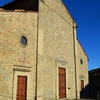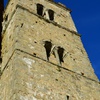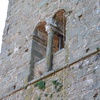Castle of Crasciana
Crasciana lies along a spur of land coming from the western slope of Mount Monticello and overlooking the valley of the river Liegora. The town has a fan-shaped layout that allows us to recognize the form of the walls that surrounded the castellated village. It is more difficult to identify the position of the oldest fortification, although we assume that the structure was in the highest part of the town, just as in the nearby village of Casabasciana.
Unfortunately, the defence structures of the castle of Crasciana have not been preserved. It can be deduced from studying historical maps that the walls had towers. The only recognizable trace of the defensive structures is an arched entrance that, despite alterations of the modern era, retains an archer slit to the right at the front.
A little lower than the settlement, a path leads to the Church of Santo alla Villa, dating from the 12th century. In 1387, it was replaced as parish seat by the Church of Saints Jacopo and Frediano, built around the 14th century in the centre of the village. Within are preserved important polychrome terracottas of the Annunciation by Andrea della Robbia and a wooden crucifix dating from the 14th century by the Master of Crasciana.
Historical notes
The “loco” and "villa" of Crasciana are remembered by written sources from ancient times. The first documentary evidence of the village, indeed, is from 951. Of the castle, founded by the Porcaresi family but later passed to the Lupari family, we have written information only from the 14th century, when it came under the possession of the City of Lucca, after Castruccio Castracani in 1316 ended Lupari rule over the lands of their ancestors. In 1331, Crasciana also participated in the rebellious riots led by Francesco Castracani and Alderigo Antelminelli. Later was the election of new castellani, or castle rulers, by appointment of the Elders during the years 1369 and 1370, after liberation from the yoke of Pisa. In 1385, the fort was repaired to for re-use after the destruction wrought by neglect and Florentine incursions during previous years.
In 1395, a warden appointed by the government of Lucca oversaw the fortress of Crasciana until 1648, when the Republic of Lucca entrusted it to the people who inhabited a small fraction of the fortress, which apparently had lost much of its tactical function.
The church of San Frediano, called “The Saint of the Villa”, was built further down along the road leading to the village and had a quadrangular bell-tower.












